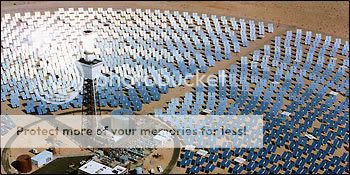California has deserts where the sun shines just about every day, winter and summer. I don't mean small places where a few panels could be put up, but many square miles that are really not good for much else, but which have abundant strong sunlight.
Yes, I'm aware of this. However in those locations there is a better system. Perhaps you have seen it. A tower with a water boiler at the top, with thousands of mirrors directing sun light at it. The water boils, and runs a steam generator.
Photovoltic is actually one of the least efficient and practical ways of converting sunlight into electricity. The world leader in solar power is Israel, and they use almost no photovoltic cells at all.
I have to hand it to the Jews. They don't get caught up in political scams, they use what works.
With that said, let me make it clear that I'm all for using whatever resources are available in the area. If you have a desert, by all means. If you have geological heat vents in your area, by all means use geothermal.
But this should be done at state level, by the locals of the area. As a national policy, this is a boondoggle in the making. Ohio doesn't have any reliable sun light. Ohio doesn't have any geological heat vents. Ohio doesn't have any consistent wind (as if it would help). We have gas, coal, uranium.
Forming national policy that hinders us and rewards you, would not only be immoral, but also an economic disaster.
If a power plant has to produce all of the time, then hydro power is not a viable option, as they depend on adequate water. Hydro plants here work really well during the spring snowmelt, but kind of slack off in the fall when the rivers are low.
Yes and no. Yes hydropower is not a complete replacement where, like you said, during a drought or in the dry season, they slack off power production. However, unlike Solar and Wind, a hydropower plant is predictable. If the reservoir is full, you can safely shut down a coal power plant, put the fires out, shut the doors and go home... because a massive dam isn't going to go from full to dry in a days time.
Solar and Wind on the other hand can go from maximum output to near zero in 10 minutes. As such, that coal power plant might be idling, but it had better be idling, or it's lights out.
The main factor against solar is, as I said earlier, the relative cost. Once the cost comes down, that is if the cost comes down, then solar will be a viable and steady source of energy.
Yeah, but that's a huge "if", and not likely to change anytime soon. Theories about cheap photovoltaic have circulated for ages, yet they never show up. Another issue is that most research indicates that (as it stands) more electricity is used in the production of a panel, than is ever produced from the panel during it's life time. Thus we are using tons of energy to gain less back. A little known fact about photovoltaic cells is that they degrade with use, and must be replaced at regular intervals.
The same can be said for wind. We have windmills, for example, in the Coast Range mountains, where the wind usually blows 24/7 due to the temperature differential between the coast and the interior valley. That differential is pretty dependible, even if there are a few days in which the wind is unusually calm there.
And I can promise you they have enough conventional power plant capacity to cover every single wind mill you have. So what's the point?
One source that can't be shut down easily is nuclear. Once a nuclear plant comes on line, the supply is pretty much assured, whether it is needed at the moment or not. That's why combining nuclear and something else is a good idea.
Not true. That is a urban myth based on old out dated information. I used to think that as well, but this is because we (the U.S.) have not continued to develop nuclear technology like other nations have. The latest generation of nuclear power plants can but put into a low power, low burn mode just as easily as any other power plant type.
However, there is another reason for this myth. Nuclear power plants are by far, the cheapest most cost effective, least upkeep, power generation available. Therefore, when a power company chooses which power plant to shut down during low demand, which is it going to choose? The expensive natural gas plant? The moderate coal plant? Or the extremely cheap nuclear plant? It'll be the gas and coal first. Not because you can't switch a nuclear reactor off, but because the others are more expensive.
Nuclear reactors are shut down routinely. They if I remember right, in a four-core plant, one reactor is shut down each mouth for routine maintenance checks and safety inspections. (I'd have to double check, but that sounds right)
Just drilling isn't going to get us energy independent.
I respectfully disagree!


